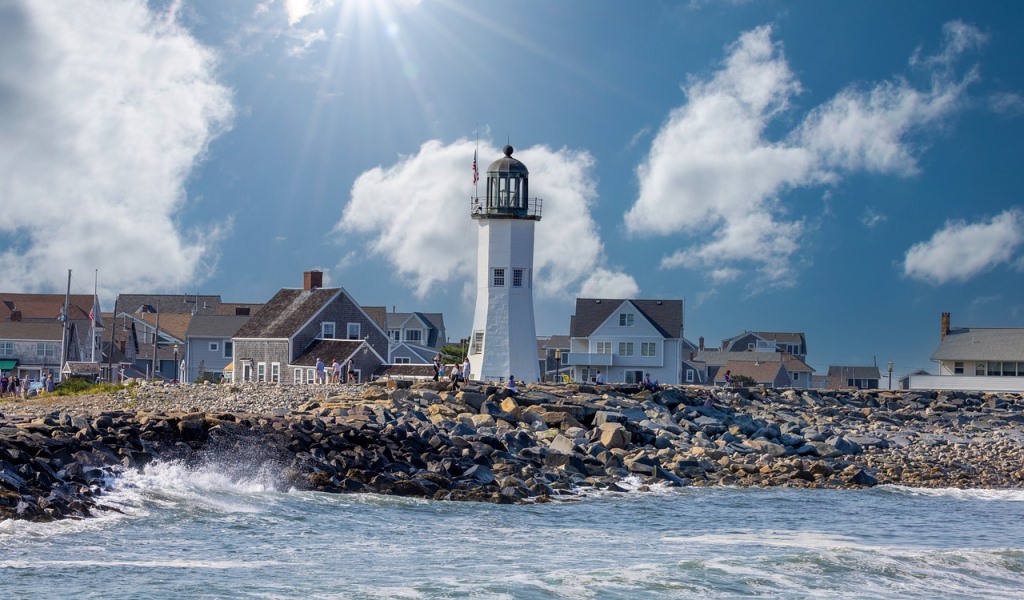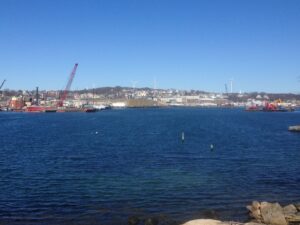The former Gloucester Gas Light Company Manufactured Gas Plant (MGP) is owned by National Grid, and is located within a heavily used, industrialized waterfront area of Gloucester, Massachusetts (of The Perfect Storm fame).
Between 1854 and 1952, the former Gloucester Gas Light Company operated a manufactured gas plant (MGP) along the Gloucester waterfront in the vicinity of the present-day Harbor Loop and Rogers Street along the Inner Harbor.
The MGP used industrial processes to produce manufactured gas from coal and oil. Customers used the gas primarily for the same purposes we use natural gas today (e.g., lighting, cooking and heating). MGPs, which were common before the development of the region’s natural gas pipelines, often yielded by-products of the gas production process such as tars, sludges, and oils.
Production at the gas plant ended in the early 1950s and ownership changed to the North Shore Gas Company, a predecessor of the current owner, National Grid.
A commercial area and Solomon Jacobs Park were later constructed on the site, and a U.S. Coast Guard station was eventually established on a portion of the area.
What Were the Impacts?
Hazardous chemicals from coal tar (principally PAHs) released by the former manufactured gas plant contaminated soils and groundwater, as well as sediment in the adjacent Gloucester Harbor.
These pollutants pose a potential risk to fish and wildlife species that depend upon this area for habitat, including the benthic organisms that make up the bottom of the food chain directly impacted by the contaminated sediments.
What’s Happening Now?
National Grid worked with the Massachusetts Department of Environmental Protection to clean up contamination from the former gas plant.
The cleanup, begun in 2015, includes removal of contaminated soils, sediment, and groundwater, capping of some park and harbor areas with clean fill, and construction of a new seawall to protect the harbor. The majority of offshore sediment dredging is completed, and all cleanup activities were concluded in 2017.NOAA and the other natural resource trustees are working cooperatively with National Grid to conduct a Natural Resource Damage Assessment. This process will determine the appropriate type and amount of restoration needed to compensate the public for injuries to natural resources and associated lost recreational opportunities.
On July 12, 2023, a $5.368 million settlement was proposed in Federal District Court to restore natural resources impacted by contaminants discharged along the Gloucester waterfront. DOJ accepted public comments on the Agreement for 30 days.
“The State of Massachusetts is bringing a comprehensive remedy to a contaminated harbor within an area known for its beauty and recreational resources. The Trustees hope to compensate the public for losses of these valuable natural resources and services,” said Ken Finkelstein, NOAA Regional Resource Coordinator.
Now, on August 24, 2023, that $5.38 million settlement was finalized to restore natural resources impacted by contaminants discharged along the waterfront.
The final consent decree provides a Natural Resource Damage Assessment (NRDA) restoration settlement value of $5,380,000, including $5,300,000 for restoration projects and $68,000 to reimburse the trustees for the remaining portion of past damage assessment costs.
The trustees will work with the public to identify and select potential restoration projects. A restoration plan will be drafted and released for public comment in the coming months.
Background
The Phase II Comprehensive Site Assessment (CSA) reported that between 1854 and 1952, the former Gloucester Gas Light Company (GGLC) operated an MGP along the Gloucester waterfront, in the vicinity of present-day Harbor Loop. In 1952, gas manufacture at the Site ceased, and all of the GGLC land holdings were sold, with the exception of one small parcel located along what is currently Rogers Street.
The GGLC was consolidated into the North Shore Gas Company in 1953. The North Shore Gas Company was owned at one time by predecessor companies of National Grid.
The former MGP structures were apparently dismantled sometime between 1952 and the late 1960s. Most of the former MGP infrastructure was located on the present-day Solomon Jacobs Park, a public day-use only park located at 19R Harbor Loop.
The boundaries of the Site include both the upland portion where MGP activities occurred as well as portions of the inner harbor where constituents consistent with MGP activities have been detected.
A toxic release associated with the Site was first reported to MassDEP in 2003, when an unknown quantity of “creosote oil” was released to surface water and sediments during the driving of piles for a new U.S. Coast Guard dock.
Soon after, National Grid presented to MassDEP an August 2006 Phase I Initial Site Investigation Report that concluded that a release of MGP residuals, which include hazardous substances primarily polyaromatic hydrocarbons (PAH), had occurred at their former MGP facility and this release had directly impacted or migrated to various Site media including soil, groundwater, sediments, and possibly surface water.
These releases occurred over the lifetime of the MGP facility but a more recent release was confirmed on August 10, 2005, during a geotechnical investigation of a pier at this property. Preliminary response actions included the collection and analysis of soil, groundwater, surface water and sediment samples from Solomon Jacobs Park, the National Grid property, and the harbor area immediately adjacent to these properties.
Photo of Gloucester, Massachusetts lighthouse by Mohan Nannapaneni from Pixabay.


